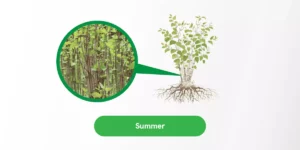According to one estimate, 5% of UK homes are afflicted with knotweed, potentially slicing £20bn off their collective value, making homes more difficult to sell.
While the exact figure can be debated, there’s no doubt that this invasive plant can pose a serious problem for homeowners. Identifying it early is crucial to prevent its spread and ensure a smooth sale when the time comes.
This guide is meant to lead property owners in the right direction when it comes to detecting this invasive plant. It considers how Japanese Knotweed appears throughout the year, other plants that it is sometimes mistaken for, and risk factors associated with an infestation.
How to Identify Japanese Knotweed
Identifying Japanese Knotweed can save property owners time, money, and hassle. This guide outlines the key features you should be aware of throughout the year:
Japanese Knotweed Shoots (Spring):
- Resemble red/purple asparagus spears, emerging from the ground in March or April.
- Grow rapidly, reaching up to 10cm per day.
- Canes reach up to 3 meters tall when mature.
- Shoots have distinctive red/pink tips and grow 1-3 cm wide.

Japanese Knotweed Leaves (Spring & Summer):
- Bright green, heart-shaped leaves with a pointed tip.
- Arranged in an alternating pattern along the stem in a zig-zag pattern.
- Each leaf can grow up to 20 cm long.

Japanese Knotweed Flowers (Late Summer):
- Creamy-white flowers bloom in clusters (panicles) from late August to mid-September.
- Flowers can grow up to 10 cm long and 0.5 cm wide, obscuring the stems.
- The presence of flowers indicates a well-established infestation, potentially requiring professional removal.

Japanese Knotweed Throughout the Year:
- Summer: Knotweed grows at its fastest rate, reaching heights of 2-3 meters and forming dense foliage.
- Autumn: Leaves turn yellow and eventually fall, while seed cases develop.
- Winter: The plant appears dormant with only brittle stems above ground. However, the root system remains active underground.

Plants Similar to Japanese Knotweed
Several plants share some characteristics with Japanese Knotweed, but key differences exist:
- Russian Vine: Faster-growing climber with divided leaves and small white flowers.
- Common Honeysuckle (Leycesteria Formosa): Woody shrub with tubular red flowers and hollow stems.
- Broad-leaved Dock: Large, green leaves with prominent veins and reddish-brown flower clusters.
- Lilac: Woody shrub with clusters of fragrant purple flowers and heart-shaped leaves.
- Bindweed: Twining vine with green, heart-shaped leaves and trumpet-shaped flowers (often white or pink).
- Bamboo: Hollow, segmented stems but lacks the distinctive zig-zag leaf arrangement of Knotweed.
- Houttuynia: Heart-shaped leaves with variegated green and white markings
If unsure about a suspected plant, consulting a professional or using a reliable online identification tool is recommended.
Risks of a Japanese Knotweed Infestation
Dealing with a Japanese Knotweed infestation is no small matter. Here’s why you really need to pay attention if this plant starts popping up on your property:
- Your Wallet Takes a Hit: When word gets out that your property is playing host to Japanese Knotweed, its value might drop like a rock. Think about it – if you were buying a house, would you choose one with an invasive plant problem? This situation can lead to a significant financial hit, especially if you’re planning to sell anytime soon.
- It’s Tough on Your Home: Japanese Knotweed doesn’t mess around. Its roots dig deep and can stretch far and wide, searching for moisture. This might sound like good hustle, but not when it’s tearing through the concrete of your driveway, sneaking under your house, or busting up your patio. Fixing this kind of damage is not only a headache; it can also be super costly.
- It Spreads Like Wildfire: You might see a little Knotweed today, but give it a blink, and it could take over your garden tomorrow. This plant spreads two ways: through its underground roots (rhizomes) and by pieces of the plant itself that break off and start new colonies. This makes it incredibly hard to control, and before you know it, what was once a small problem has taken over your entire outdoor space.
- Selling Your House? Good Luck: Here’s where it gets even trickier. If you’re looking to sell your house and it’s got a Knotweed problem, you might find that buyers are few and far between. This is because many mortgage lenders see Knotweed as a big red flag. They might not lend money to potential buyers unless you can show that the Knotweed has been professionally dealt with and there’s a plan in place to keep it from coming back.
So, what can you do? First, don’t panic. Knowledge is power, and understanding the risks of Japanese Knotweed is the first step to tackling the problem. Getting a professional assessment and considering a removal plan is critical. It might seem like a big step, especially considering the cost and effort involved, but taking action early can save you a lot of trouble (and money) down the line.
Having Trouble Identifying Japanese Knotweed?
We understand that identification can be challenging. TP Knotweed Solutions offers a free identification service. Simply send us clear photos of the suspected plant, and our experts will respond within 24 hours to confirm or rule out the presence of Japanese Knotweed.
By familiarising yourself with the characteristics of Japanese Knotweed throughout the year, you can take control of the situation and address any potential infestation promptly. Remember, early




